Gardenia jasminoides
Gardenia jasminoides, commonly known as gardenia,[2] is an evergreen flowering plant of the coffee family Rubiaceae. It originated in Asia and is most commonly found growing wild in Vietnam, Southern China, Korea, Taiwan, Japan, Myanmar, India and Bangladesh. Wild plants range from 30 cm to 3 m high and have a rounded habit with very dense branches with opposite leaves, lanceolate-oblong, leathery or gathered in groups on the same node and by a dark green, shiny and slightly waxy surface and prominent veins.
| Gardenia jasminoides | |
|---|---|
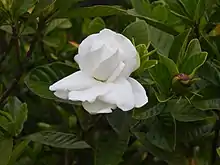 | |
| Scientific classification | |
| Kingdom: | Plantae |
| Clade: | Tracheophytes |
| Clade: | Angiosperms |
| Clade: | Eudicots |
| Clade: | Asterids |
| Order: | Gentianales |
| Family: | Rubiaceae |
| Genus: | Gardenia |
| Species: | G. jasminoides |
| Binomial name | |
| Gardenia jasminoides | |
| Synonyms[1] | |
|
List
| |
With its shiny green leaves and heavily fragrant white summer flowers, it is widely used in gardens in warm temperate and subtropical climates, and as a houseplant in temperate regions. It has been in cultivation in China for at least a thousand years, and was introduced to English gardens in the mid-18th century. Many varieties have been bred for horticulture, with low-growing, and large, and long-flowering forms.
History
Evidence of G. jasminoides in cultivation in China dates to the Song Dynasty (960-1279 AD), where both wild and double-flowered forms have been depicted in paintings, such as those of the Song Emperor Huizong,[3] and the Tenth century artist Xu Xi.[4] The Yuan Dynasty (1271–1368) saw it on lacquerware, and the Ming Dynasty on porcelain (1368–1644).[5] In 1794, English statesman Sir John Barrow saw gardenias in nurseries in Guangzhou, China.[5]
Daniel Solander reported that the species was brought to the United Kingdom in 1744 on the Godolphin by captain Hutchenson, who gave it to botanist Richard Warner of Woodford Row, Essex.[6] Warner, however, was unable to propagate it until the botanist John Ellis recommended James Gordon, a gardener at Mile End.[7] Gordon was successful in August 1757, and plants sold well thereafter;[8] each cutting-grown plant fetching five guineas.[7]
Gardenias were first grown in the United States in 1762, in the Charleston garden of Alexander Garden, who had moved there 10 years previously.[9]
Taxonomy and naming
Gardenia jasminoides was described by English botanist Ellis in 1761,[8] who realised on dissecting the flower that it was not closely related to jasmine and warranted a new genus. He initially proposed Warneria after the original plant's owner in England. However, Warner declined to have it named for him and so Ellis chose Gardenia to honour Garden.[7] It gained its association with the name jasmine as the botanist and artist Georg Dionysius Ehret had depicted it and queried whether it was a jasmine as the flowers resembled the latter plant. The name stuck and lived on as common name and scientific epithet.[8]
The name G. augusta of Linnaeus has been ruled invalid.
The common names cape jasmine and cape jessamine derive from the earlier belief that the flower originated in Cape of Good Hope, South Africa.[8] Other common names include danh-danh and jasmin.[2]
Description
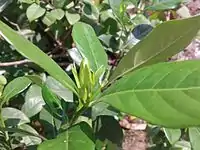
Gardenia jasminoides is a shrub that ranges from 30 cm to 3 metres (1-10 ft) high in the wild, with cylindrical to flat branches that are furry at first becoming smooth. The leaves are arranged oppositely—or rarely in groups of three—along the branches. They are either subsessile or on short 0.5-1 cm long petioles. The leaves themselves are 3-25 cm long by 1.5-8 cm wide and can be oblong-lanceolate, obovate-oblong, obovate, oblanceolate, or elliptic in shape. Their upper surface is smooth and shiny, or slightly furry along the primary veins, while the undersurface is slightly furry to smooth. Each leaf has 8 to 15 pairs of secondary veins. The flowers are solitary and terminal (arising from the ends of stems).[10]
The white flowers have a matte texture, in contrast to the glossy leaves. They gradually take on a creamy yellow color and a waxy surface. They can be quite large, up to 10 cm (4 in) in diameter, loosely funnel-shaped, and double in form. Blooming in summer and autumn, they are among the most strongly fragrant of all flowers. They are followed by small, oval fruit.[11]
Distribution and habitat
Within China the species is found in Anhui, Fujian, Guangdong, Guangxi, Guizhou, Hainan, Hebei, Hubei, Hunan, Jiangsu, Jiangxi, Shandong, Sichuan, Taiwan, Yunnan and Zhejiang provinces.[10]
Its native habitat is forest and undergrowth along streams, and on sloping and hilly terrain to an alittude of 1500 m.[10]
Cultivation
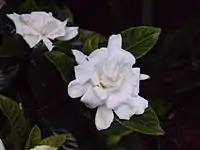
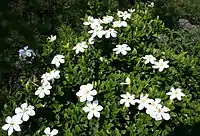
In cultivation in the UK, G. jasminoides has gained the Royal Horticultural Society's Award of Garden Merit.[12][13]
It is widely used as a garden plant in warm, temperate and subtropical gardens. It can be used as a hedge. It requires good drainage and a sunny location, and prefers an acidic soil with a pH between 5.0 and 6.5.[14] G. jasminoides is generally considered to be somewhat difficult to cultivate. As a subtropical plant, it thrives best in warm temperatures above 5 °C (41 °F)[12] in humid environments. Getting those conditions is rather hard in temperate latitudes, the reason for which gardenias are usually cultivated as houseplants or in greenhouses. In warm places, though, it can be grown outdoors. Either way, it prefers bright indirect sunlight or partial shade.
Apart from the difficulties in creating suitable conditions for the plant to live, gardenias need to be planted in an acidic soil (it is a calcifuge). If the soil is not acid enough, many of its nutrients (especially iron compounds) will not be available for the plant, since they will not dilute in water, so will not be absorbed by the roots. If this happens, gardenias start to develop chlorosis, whose main symptom is a yellowing of the leaves. (See Soil pH).
For this reason, it is advisable not to water gardenias with very hard water. When having to water with hard water, it is possible to add some vinegar or lemon juice to it before doing so, this will lower the pH of the water, or use an effective pH modifier, like phosphoric or nitric acid.
Iron chelate can be added to the soil to lower the pH, but care must be taken since an overdose can kill the plant, as with any other inorganic soil amendment.
Some gardeners spill vinegar over the soil to effectively keep the pH low and prevent chlorosis. This can be carried out either regularly or when the first symptoms of chlorosis have been spotted.
Cultivars
Many cultivars have been developed, of which the double-flowered forms are most popular. G. 'Radicans' is a low-growing groundcover which reaches 15–45 cm (6–18 in) and spreads up to a metre wide, while G. 'Fortuniana' and G. 'Mystery' are double-flowered cultivars.[11] The former was sent by Scottish botanist Robert Fortune in 1844 to the Royal Horticultural Society in London.[5] The latter has a large upright habit and has been a popular variety good for hedging. It reaches 1.8 to 2.5 m (6–8 ft) high and wide.[14]
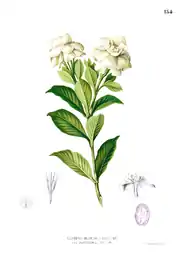
G. 'Aimee' is an early-flowering (spring) form.[15] Cultivars such as G. 'Shooting Star' and G. 'Chuck Hayes' are more cold-hardy, roughly to zone 7.[16][17] A cultivar called 'Summer Snow' is distinguished by its large flowers and grows in USDA Zones 6-10.[18] 'Crown Jewel' is a dwarf spreading variety That has survived several weeks below zero in Zone 6.
Unlike other varieties, G. 'Golden Magic' bears flowers which change to a golden yellow relatively early after opening white. It grows to 1.5 m (5 ft) high and 1 m (3.5 ft) wide.[19]
Uses
Polynesian people in the Pacific islands use the fragrant blooms in their flower necklaces, which are called Ei in the Cook Islands, Hei in French Polynesia and Lei in Hawaii. Gardenia flowers can be eaten raw, pickled, or preserved in honey.
Gardenia jasminoides fructus (fruit) is used within traditional Chinese medicine to "drain fire" and treat certain febrile conditions, i.e. have an anti-inflammatory and antipyretic effect.[20]
Shishihakuhito is a Chinese herbal medicine mainly composed of gardenia fruit, used to treat atopic dermatitis as it inhibits IgE-mediated histamine release.[21] In 2020, the case of a woman who had developed blue-gray discoloration of the skin as a result of chronic intake of gardenia fruit extract was published.[22]
Chemistry
The iridoids genipin and geniposidic acid can be found in G. jasminoides fruit.[23]
Crocetin (a chemical compound usually obtained from Crocus sativus) can also be obtained from the fruit of G. jasminoides.[24] The fruit has crocin which is used as a yellow dye,[5] which is used for clothes and food.
References
- "Gardenia jasminoides J.Ellis". Plants of the World Online. Board of Trustees of the Royal Botanic Gardens, Kew. 2017. Retrieved 4 December 2020.
- "Gardenia jasminoides". Germplasm Resources Information Network (GRIN). Agricultural Research Service (ARS), United States Department of Agriculture (USDA). Retrieved 30 November 2014.
- Keswick, Maggie (2003). The Chinese Garden (2nd ed.). London: Frances Lincoln. p. 63. ISBN 0-7112-2031-X.
- Keswick, p. 204
- Valder, Peter (1999). Garden Plants of China. Glebe, NSW: Florilegium. p. 289. ISBN 1-876314-02-8.
- "CVII. An account of the Gardenia: In a letter to Philip Carteret Webb, Esq; F. R. S. From Daniel C. Solander, M. D". Philosophical Transactions of the Royal Society of London. 52: 654–661. 1761. doi:10.1098/rstl.1761.0109. S2CID 186210214.
- "LXXXII. An account of the plants Halesia and Gardenia: In a letter from John Ellis, Esq; F. R. S. To Philip Carteret Webb, Esq; F. R. S." Philosophical Transactions of the Royal Society of London. 51: 929–935. 1759. doi:10.1098/rstl.1759.0084. S2CID 186210416.
- Foster, Steven; Yue, Chongxi (1992). Herbal emissaries: bringing Chinese herbs to the West : a Guide to Gardening, Herbal Wisdom, and Well-Being. Healing Arts Press. pp. 185. ISBN 0-89281-349-0.
- Bender, Steve (2011). "A Brief History of the Gardenia". Southern Living. Birmingham, AL: Time Inc. Lifestyle Group. Retrieved 1 December 2012.
- Chen, Tao; Luo, Xianrui; Zhu, Hua; Taylor, Charlotte M.; Ehrendorfer, Friedrich; Lantz, Henrik; Funston, Michele; Puff, Christian. "Gardenia jasminoides". Flora of China. 19. Retrieved 6 January 2021 – via eFloras.org, Missouri Botanical Garden, St. Louis, MO & Harvard University Herbaria, Cambridge, MA.
- Gilman, Edward F. (October 1999). "Fact Sheet FPS-222: Gardenia jasminoides" (PDF). University of Florida: Institute of food and agricultural sciences. Retrieved 2011-10-22.
- "Gardenia jasminoides AGM". Royal Horticultural Society. Retrieved 7 July 2020.
- "AGM Plants - Ornamental" (PDF). Royal Horticultural Society. July 2017. p. 39. Retrieved 27 February 2018.
- Bussell, Gene A. (June 2005). "Gardenias: A Fragrance That Captivates". Southern Living. Birmingham, AL: Time Inc. Lifestyle Group. Retrieved 1 December 2012.
- Hériteau, Jacqueline (2005). Complete trees, shrubs & hedges. pp. 179. ISBN 1-58011-259-5.
- "Gardenia jasminoides 'Shooting Star'". Missouri Botanical Garden's Kemper Center for Home Gardening.
- United States Plant Patent PP19896
- U.S. Patent PP22797
- Plantmark (2006). "Gardenias". self. Archived from the original on 10 April 2013. Retrieved 1 December 2012.
- Bensky, Dan; et al. (2004). Chinese Herbal Medicine Materia Medica (3rd ed.). Seattle: Eastland Press, Inc. p. 95.
- Mie WAKABAYASHI, Eiko SAKURAI, Kazuhiko YANAI, Kazuhiro UMEMURA, Masaaki YOSHIDA, Yasushi OHIZUMI, Tohru YAMAKUNI (2009). "Shishihakuhito, a traditional Chinese medicine for atopic dermatitis, inhibits IgE-mediated histamine release from rat RBL-2H3 basophilic leukocyte cells". Journal of Traditional Medicines. 26: 44–49.CS1 maint: multiple names: authors list (link)
- Mizawa, Megumi; Andoh, Tsugunobu; Shimizu, Tadamichi (2020-03-01). "Gardenia Fruit–Related Blue-Gray Skin Pigmentation". JAMA Dermatology. 156 (3): 351. doi:10.1001/jamadermatol.2019.4682. ISSN 2168-6068.
- Koo, HJ; Lim, KH; Jung, HJ; Park, EH (2006). "Anti-inflammatory evaluation of gardenia extract, geniposide and genipin". Journal of Ethnopharmacology. 103 (3): 496–500. doi:10.1016/j.jep.2005.08.011. PMID 16169698.
- Yamauchi, M; Tsuruma, K; Imai, S; Nakanishi, T; Umigai, N; Shimazawa, M; Hara, H (2011). "Crocetin prevents retinal degeneration induced by oxidative and endoplasmic reticulum stresses via inhibition of caspase activity". European Journal of Pharmacology. 650 (1): 110–9. doi:10.1016/j.ejphar.2010.09.081. PMID 20951131.
External links
| Wikimedia Commons has media related to Gardenia jasminoides. |
